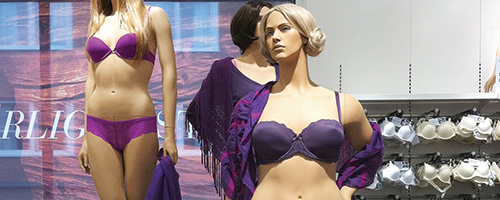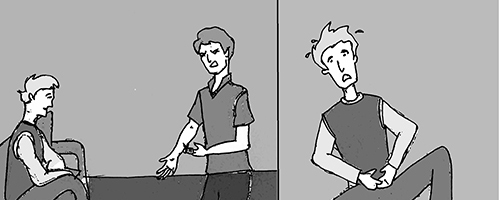The Internet was all abuzz over a photo Women’s Rights News posted on its Facebook wall a couple of weeks ago. Thousands of people have since “liked” it and, no, it wasn’t another cute cat photo.
‘Full-figured’ mannequins make the news

The Internet was all abuzz over a photo Women’s Rights News posted on its Facebook wall a couple of weeks ago. Thousands of people have since “liked” it and, no, it wasn’t another cute cat photo.
Well, apparently an overwhelming number of people were indeed inspired. Though the mannequins wore scantily-clad underwear in a Swedish department store called Ahlens, the response had nothing to do with what they were wearing. It was about how uncommonly round they were.
Yes, there were “full-figured” mannequins in a store—gasp! Groundbreaking! OK, I get that it’s revolutionary to see a mannequin who doesn’t have her hip bones jutting out and her waist pinched into a 23-inch, almost-not-there impossibility. It’s just sad that a “full-figured” one would be so astonishing as to make front-page news.
Among many others, Delia Lloyd from The Washington Post wrote a response to the photo, and described the “zaftig” mannequins as “an encouraging sign of the times.” I’d never heard of this word—zaftig—so I looked it up. According to The Merriam-Webster Dictionary, it’s “of a woman: having a full, rounded figure; pleasingly plump.”
What strikes me first is that it’s only “of a woman.” Notably illuminating that the word is a uniquely feminine bodily description—then again, when was the last time you heard someone describe the shape of a man’s body? Even more interesting is “pleasingly plump.” Obviously, one can be unpleasingly plump. I’d love to know where the line between those two is.
I looked further into the word’s origin and discovered it comes from the Yiddish zaftik, which means “juicy; succulent.” How often do you think of your body as juicy and succulent?
Every day, I hope.
So, anyway, the photo sparked a lively dialogue around women’s body size, image and ultimately, the need for more of these mannequins that were, as the photo’s caption read, what “real women” look like.
I get what they’re saying and their motivation is great. For a large percentage of us, the Barbie-like dimensions of typical mannequins are completely unrealistic and reflect a very narrow segment of body types. We’ve been taught that’s the norm and, of course, no one wants to fall short of that.
However, in an attempt to foster a different expression of the “norm”—which is itself a social construction with no basis in fact—aren’t we just falling into the same trap? To insist that larger-sized mannequins look like “real women” suggests that, first, we can define what is “real,” and second, it’s still a woman’s size that defines her. If we were really looking for true representations of women, we would have brown mannequins, little-people mannequins, mannequins with disabilities and many, many more.
It’s crucial to represent more than just one size of woman, but it’s dangerous to claim that there’s something more “real” about a plumper woman than a thinner one and vice versa.
Don’t we get it? We’re just shifting the sand from one side of the sandpit to the other. We need to get out of the mire and stop playing games.
A size-four woman and a size-20 woman are equally real. They’re both flesh, bones and blood, and some other things between. What’s not real is the number they’ve just used to describe themselves. That a one- or two-digit number defines whether we feel good about ourselves as we walk out of the fitting room door is depressing.
In the vast majority of cultures, the larger, rounder and curvier you are, the better. Thin people are encouraged to eat up so as not to look sick. That’s their norm. So, really, there is no norm. And there shouldn’t be. Just human beings. The more time we spend measuring the width of our hearts, the length of our patience and the breadth of our compassion, the less time we’ll waste deciding what’s real and what isn’t and hating ourselves in the process.
Three cheers for different mannequins, but even more for the day when we’ll stop looking to plastic figurines to tell us we’re OK. All we’ll need to know when we walk out the door is that we’re perfectly succulent. Full stop.





